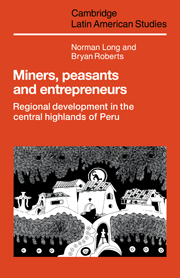Book contents
- Frontmatter
- Contents
- List of tables
- List of figures
- List of maps
- Preface
- 1 Regional development in an export economy
- 2 The development of a regional economy in the central highlands
- 3 The Mining Corporation and regional development
- 4 Class relations, local economies and large-scale mining
- 5 Highland puna communities and the impact of the mining economy
- 6 Migration and social differentiation amongst Mantaro valley peasants
- 7 Industrialization and the emergence of an informal regional economy
- 8 The village economy, agricultural development and contemporary patterns of social differentiation
- 9 Regional commitment among central highlands migrants in Lima
- 10 Confederations of households: extended domestic enterprises in city and country
- 11 Regional development in peripheral economies
- Notes
- Bibliography
- Index
- Titles in the series
2 - The development of a regional economy in the central highlands
Published online by Cambridge University Press: 07 May 2010
- Frontmatter
- Contents
- List of tables
- List of figures
- List of maps
- Preface
- 1 Regional development in an export economy
- 2 The development of a regional economy in the central highlands
- 3 The Mining Corporation and regional development
- 4 Class relations, local economies and large-scale mining
- 5 Highland puna communities and the impact of the mining economy
- 6 Migration and social differentiation amongst Mantaro valley peasants
- 7 Industrialization and the emergence of an informal regional economy
- 8 The village economy, agricultural development and contemporary patterns of social differentiation
- 9 Regional commitment among central highlands migrants in Lima
- 10 Confederations of households: extended domestic enterprises in city and country
- 11 Regional development in peripheral economies
- Notes
- Bibliography
- Index
- Titles in the series
Summary
In this chapter, we outline the major social and economic processes that created a regional system in the central highlands. Our main interest will be to examine the linkages that developed between the mines and the agrarian sector during the colonial period and into the nineteenth century. An important part of this process was the strengthening of village institutions and the consolidation of small-scale economic enterprise in trade and agriculture. The expansion of local economic enterprise prior to the twentieth century and the class interests to which this gave rise show some important continuities with the effects of large-scale modern mining which we analyse in the next chapter.
The colonial economy of the central highlands
Almost from the beginning of Spanish colonial rule, mining shaped the social and economic organization of the central highlands. From the seventeenth century, the Cerro de Pasco area developed as an important producer of silver and fry the late eighteenth century it was the major South American source, replacing Potosí (Fisher, n.d.: 21). In addition, the Santa Barbara mine at Huancavelica, to the immediate south of the area, was the primary American source of mercury, which was essential to the amalgamation process of silver extraction. The central highlands and especially the Mantaro valley provided labour, fodder, foodstuffs and timber for these mining complexes.
The relationship between mining and agriculture in the Peruvian Andes developed differently from the system of production that Palerm (1976) describes for colonial Mexico. The Mexican system was essentially based on large-scale mining enterprises which were serviced by haciendas, often owned by the mine owners, which in turn depended on the skills, labour and land reserves of the Indian communities.
- Type
- Chapter
- Information
- Miners, Peasants and EntrepreneursRegional Development in the Central Highlands of Peru, pp. 25 - 43Publisher: Cambridge University PressPrint publication year: 1984



